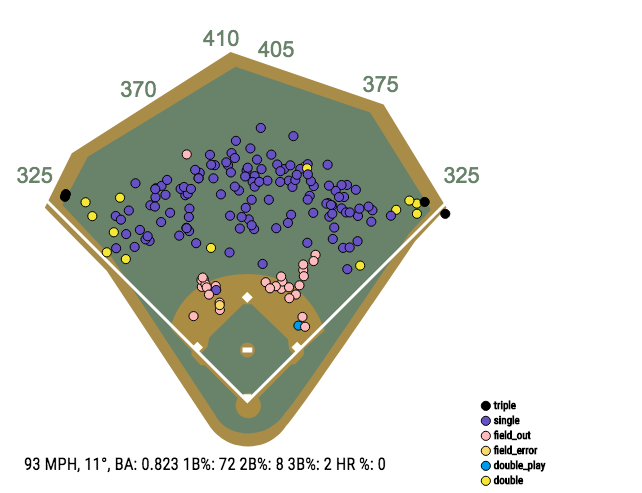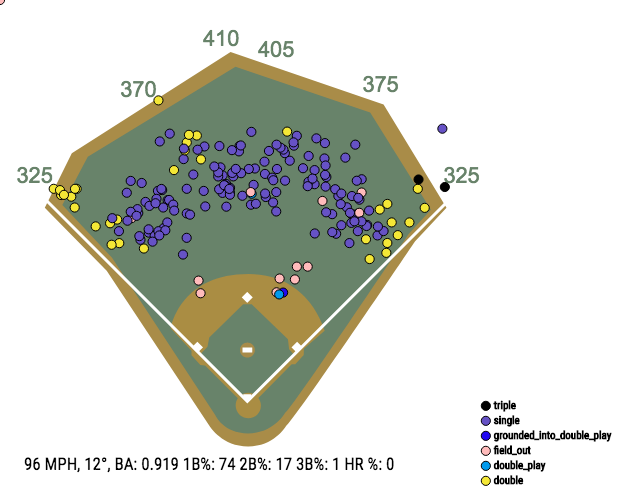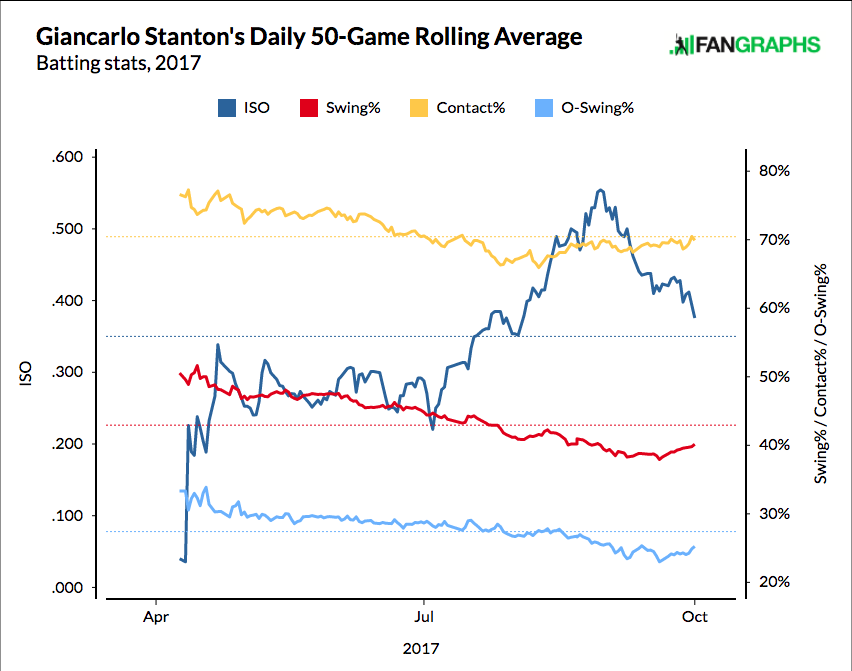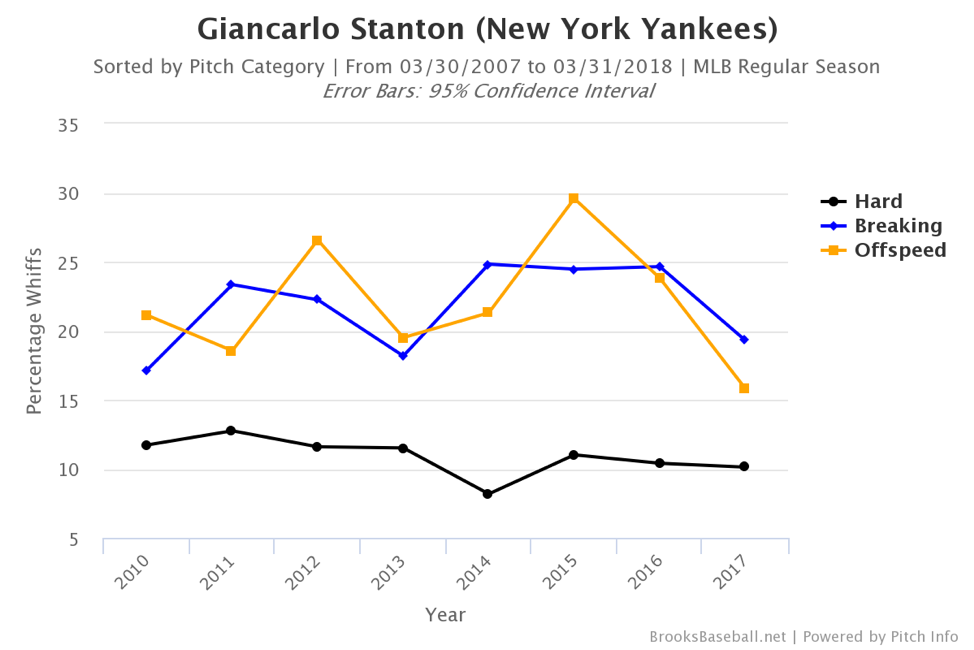(Photo by John Adams/Icon Sportswire)
Giancarlo Stanton needed only two pitches to bank his first home run as a member of the New York Yankees. All of the offseason excitement and hype materialized in one lightning-fast swing on a low fastball from J.A. Happ. The 117.4 MH “fliner”, a combination of fly-ball and line drive, would have been the 7th fastest hit of 2017. Baseballs being crushed inhumanely have become a standard expectation of Stanton over his first eight seasons in the majors. Since Baseball Savant began collecting exit velocity data in the 2015 season, Stanton has found himself inside the Top 10 for FB/LD and overall average exit velocity, when viewing samples that have 80+ batted ball events. His launch angle isn’t optimal, but damaging the baseball in this way causes Stanton to fall into more hits and home runs than average hitters. Below is a Statcast visualization that displays outcomes of batted ball events from around the league that had velocity and angle parameters similar to Stanton’s 2017 average.

The above image also represents his worst year for exit velocity and launch angle. This particular BBE hovers at an .823 AVG. Stanton was living within this range throughout last season. Players with comparable EV/LA numbers were Manny Machado, Bryce Harper, J.D. Martinez, Paul Goldschmidt, Khris Davis, Joey Gallo, Aaron Judge and Gary Sanchez; clearly, a list on which any hitter would love for their name to appear. Going back to the seasons prior we find Giancarlo around 96 MPH and 12 degrees. Below is a visual that represents similar BBE to his 2015-2016 EV/LA profile which was incredibly elite.

This is the point of the article when I expect the comment, “Okay Paul, we get it. Giancarlo Stanton is a massively built human that hits baseballs very hard. We’ve known this; it’s nothing new.” I hear you, and appreciate the feedback, but Stanton also made a ton of other improvements in 2017 to round out his complete hitter profile. These changes began with the closing of his batting stance. Stanton moved his front leg forward in the box, displayed his back to the pitcher more prominently, and that’s when everything started to click.
[gfycat data_id=”CaninePepperyBagworm”]
In this .gif, one can see the progression from upright to close over the course of a month. The first paragraph explains that Stanton has been amazing ever since the inception of Statcast data; so the question is: “Why were these changes necessary?” He has been on record saying that closing his stance prevented his hips from “leaking”. Normally when power hitters are opening too early, as Stanton claims, they are not able to create the same amount of bat speed through the zone. Power swings increase bat speed and lift post-contact, whereas “leaking” hips would generate velocity before the bat hits the ball, dragging the barrel through the zone much slower. While watching film of himself, Stanton noticed that adjustments could optimize his already elite bat speed. In an NY Daily News article, he stated, “I’d seen on video that when I would strike in a closed position I hit the ball hard…Homers, hits, balls to the opposite field, really everywhere; so I thought I’d start in that position.” Stanton’s adjustments allowed him to make more quality contact, but further changes in the approach truly molded him into one of the deadliest men in the world with a baseball bat, outside of Jeffrey Dean Morgan. Many elite exit velocity, launch angle, “three true outcome” hitters have a problem with contact ability. Stanton could smash any part of the field but had issues hitting the ball.

Over the course of 2017, a decrease in Swing% and O-Swing% correlated with a huge spike in isolated power. Stanton’s batting stance was fully closed by the end of July, during the months of adjustment he slowed down and saw more pitches. Improving his patience at the plate was a strive for comfort in his newfound approach. The same Daily News article quoted Stanton as feeling “a little locked” at first. Clearly, he discovered some rhythm in his new approach and displayed it with colossal ISO numbers in the final few months. Stanton hit 26 HR with a .293 average in his final 243 PA. These impressive stats were paired with a career-high contact rate and a career-low in SwStr%, O-Swing%, and K%. Stanton showcased his patience at the plate by posting a 20.9% Ahd, which was ninth overall. Ahd can be found on Matthew Carruth’s Statcorner.com and is the percentage of pitches a hitter sees in favorable counts. Stanton placed near Daniel Murphy, Bryce Harper, Brett Gardner, Justin Turner, and other extremely persistent hitters with elite walk rates. Favorable counts have always been part of Stanton’s game mainly because pitchers are scared of what he could potentially do with any of their offerings. Staying closed in his stance allowed him to see pitches further into the zone. Stanton recognized off-speed and breaking balls much easier by utilizing his new stance and combining it with his ability to get ahead in counts.


The table above displays Stanton’s development against breaking and off-speed offerings last year. It is quite staggering what he was able to accomplish whilst completely redesigning his stance in the middle of the summer. Closing his front leg created consistency in the approach, power, bat speed, and slowed down his batting eye to lay-off pitches he would have swung and missed at earlier in his career. His whiff percentages decreased in each pitch type and seriously improved against the secondary stuff. Stanton brought the whiffs against breaking pitches under 20% for the first major sample of his career and was even better against changeups.
Giancarlo Stanton is putting on pinstripes this year as the third bash brother in a movie that stars Aaron Judge and Gary Sanchez opposite the former Miami stud. The New York Yankees have put together one of the most feared middle-of-the-orders in the league. Stanton claims that the new stance is not going anywhere and hopefully the patience that came along with it can stick. His improvements went far beyond simply moving his foot in the batter’s box. Stanton became an all-around offensive weapon in 2017 by cutting his strikeouts, recognizing pitches on a higher level, getting ahead in counts, and of course, hitting MASSIVE tanks. Improving basically every facet of his game, including the power he was already known for, Stanton was able to hit 59 HR in his worst exit velocity season on record. It is pure insanity to project him for any more than that, but his raw power numbers have been better in the past. If what he did at the plate after July 31st carries over to a full season, 60 HR may be more of a floor than a pipe-dream.

